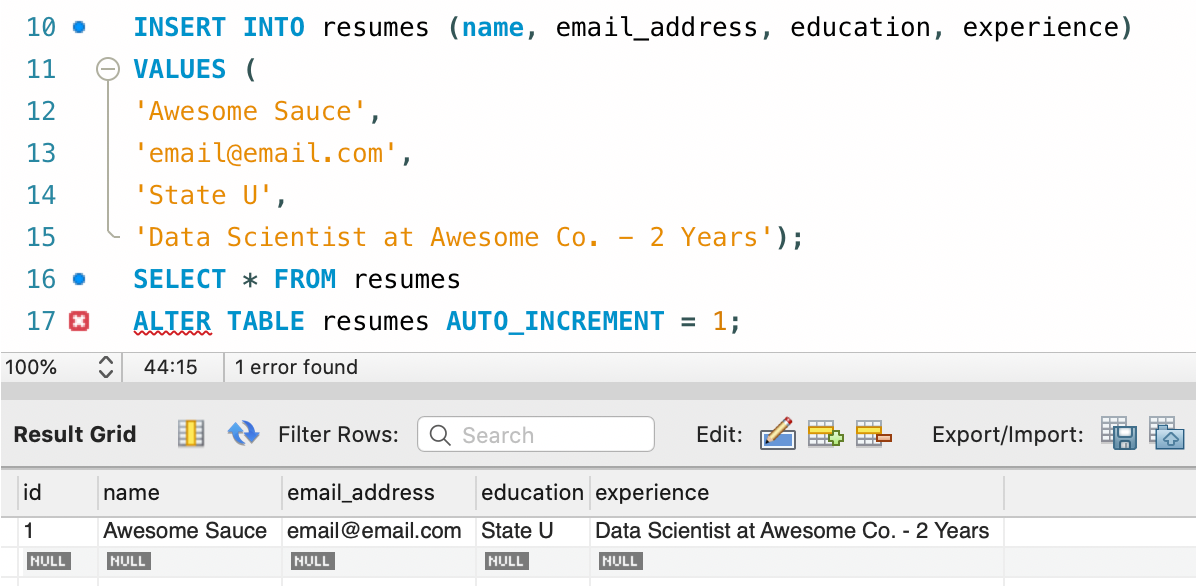Date: October 14, 2020 12:37PM
Unable to install MySQL on macOS Catalina. Posted by: Paul Johnson Date: October 14, 2020 12:37PM I download and install MySQL. I go to the MySQL Pane in System. In this tutorial, I will show you how to setup/install Apache, PHP, and MySQL on macOS Catalina. Open the Terminal app and switch to the root user so you can run the commands in this post without any permission issues: 0001. Enable Apache on macOS. As you might know, the MySQL Community Edition is available for macOS. Usually, I install MySQL server on Linux server but this time, I want to try it on my Hackintosh macOS Catalina. Steps to Install MySQL Server on macOS Catalina Step 1. Download the MySQL Server installation package. Navigate to the following link to download your copy of. I'm trying to setup up MySQL on mac os 10.6 using Homebrew by brew install mysql 5.1.52. Everything goes well and I am also successful with the mysqlinstalldb. However when I try to connect to the.
I tried manually loading the launchd file with
sudo launchctl load -F com.oracle.oss.mysql.mysqld.plist
Now in the MySQL System Preferences Pane I see the two red indicators flashing momentarily green, so MySQL is at least being awakened but appears to be quickly dying.
I haven't found any posts that help with my particular problem(s). Any assistance would certainly be appreciated.

Content reproduced on this site is the property of the respective copyright holders. It is not reviewed in advance by Oracle and does not necessarily represent the opinion of Oracle or any other party.
Recommend switching to Docker
I finally switched to using Docker for local development on macOS. While the following tutorial works for macOS Catalina, it has limitations. I recommend following my latest tutorial on installing Apache, MySQL, and PHP on macOS using Docker.
Note: This post is for new installations. If you have installed Apache, PHP, and MySQL for Mac OS Mojave, read my post on Updating Apache, PHP, and MySQL for macOS Catalina.
I am aware of the web server software available for macOS, notably MAMP, as well as package managers like brew. These get you started quickly. But they forego the learning experience and, as most developers report, can become difficult to manage.

Install Mysql 5.7 Mac Catalina
macOS runs atop UNIX. Most UNIX software installs easily on macOS. In Additional, Apache and PHP come preinstalled with macOS. So to create a local web server, all you need to do is configure Apache and install MySQL.
Running Commands
First, open the Terminal app and switch to the root user so you can run the commands in this post without any permission issues:
Enable Apache on macOS
Verify It works! by accessing http://localhost
Enable PHP for Apache

First, make a backup of the default Apache configuration. This is good practice and serves as a comparison against future versions of macOS.
Now edit the Apache configuration. Feel free to use a different editor if you are not familiar with vi.
Uncomment the following line (remove #):
Restart Apache:
You can verify PHP is enabled by creating a phpinfo() page in your DocumentRoot.
Can I Install Mysql On Mac
The default DocumentRoot for macOS Catalina is /Library/WebServer/Documents. You can verify this from your Apache configuration.
Now create the phpinfo() page in your DocumentRoot:
Verify PHP by accessing http://localhost/phpinfo.php

Install MySQL on macOS Catalina
Brew Install Mysql Mac Catalina
Download and install the latest MySQL generally available release DMG for macOS. MySQL 8 is the latest version. But older versions are available if you need to support older applications.
When the install completes it will provide you with a temporary password. Copy this password before closing the installer. You will use it again in a few steps.
The README suggests creating aliases for mysql and mysqladmin. However there are other commands that are helpful such as mysqldump. Instead, you can update your path to include /usr/local/mysql/bin.
Note: You will need to open a new Terminal window or run the command above for your path to update.
Finally, you should run mysql_secure_installation. While this isn't necessary, it's good practice to secure your database. This is also where you can change that nasty temporary password to something more manageable for local development.
Connect PHP and MySQL
You need to ensure PHP and MySQL can communicate with one another. There are several options to do so. I like the following as it doesn't require changing lots of configuration:
Additional Configuration (optional)
The default configuration for Apache 2.4 on macOS seemed pretty lean. For example, common modules like mod_rewrite were disabled. You may consider enabling this now to avoid forgetting they are disabled in the future.
Install Apache Mysql Php On Macos Catalina
I edited my Apache Configuration:
I uncommented the following lines (remove #):
If you develop multiple projects and would like each to have a unique url, you can configure Apache VirtualHosts for macOS.
If you would like to install PHPMyAdmin, return to my original post on installing Apache, PHP, and MySQL on macOS.
Install Mysql On Mac Catalina Free
Find this interesting? Let's continue the conversation on Twitter.